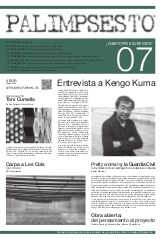Gravity and light: eternal matters of architecture
DOI:
https://doi.org/10.5821/pl.v0i7.1280Abstract
There is not a single work of architecture in the world which,in its quest to build the space, has been able to evade theeffects of terrestrial gravity or has been able to do withoutthe effects of sunlight. This has been expressed in recentyears by the most important architects of our country. Butthe understanding of the architectural significance of thesephenomena is not a discovery of modernity.
This paper aims to make clear that light and gravity havebeen important issues for architectural theory since ancienttimes. Vitruvius notes in his treatise on architecture, the oldestof its kind, the central importance of gnomonics andmechanics, the sciences that study the movement of lightand gravitational matter respectively. A millennium and ahalf later, Christopher Wren reinterprets the Vitruvian principlesand writes a short treatise on architecture, where heshows that Optics and Statics are the geometrical reasonsfor the beauty and strength of architecture. Three centurieslater, Arthur Schopenhauer states, in his architectural masterpiece,that architecture intends to express the eternalideas of gravity and light.
Light and gravity are fundamental questions in architecture.This is not disputed by anyone. But only a few knowthe scientific origin of the architectural interest in theseissues.
Downloads
Issue
Section
License
PROTECTION AND INTELLECTUAL PROPERTY CRITERIA
Authors whose work is published in en Palimpsesto agree to the following terms:
1. The author retains the copyrights and guarantees the magazine the right to apply a Creative Commons Attribution-NonCommercial-NoDerivatives (CC BY-NC-ND), which permits others to share the work with acknowledgement of authorship.
2. The author may establish additional agreements of his or her own accord for non-exclusive distribution of the article published in the magazine (for example, in an institutional repository, or published in a book).
3. Electronic distribution of the work by the author(s) is permitted and encouraged (for example, in institutional repositories or on the author’s own website), prior to, and during the submission process, as this can generate productive exchanges, as well as earlier and greater citation of the published works (see The Effect of Open Access) (in English).
4. The author or provider of the material submitted for publication authorizes Palimpsesto to publish, with no obligation whatsoever (financial or otherwise) to the content of said material, be it in paper or digital format, or in any other medium.
5. The author or provider guarantees that he or she is the owner of the Intellectual Property rights to the contents provided, which encompasses the text and images/photographs/photographic works incorporated in the article.
6. The author or provider, exempts Palimpsesto magazine of all and any responsibility relating to violation of copyrights, thereby committing himself or herself to undertaking all efforts to assist Palimpsesto magazine in defence of any accusation, extra-judiciary, and/or judicial measures. Likewise, the author or provider will assume payment to Palimpsesto of any sum or compensation that must be paid to third parties for failure to comply with these obligations, be it the result of judicial, arbitrary or administrative decisions.
7. The submission of the texts by authors implies automatically a declaration of non plagiarism of its contents







